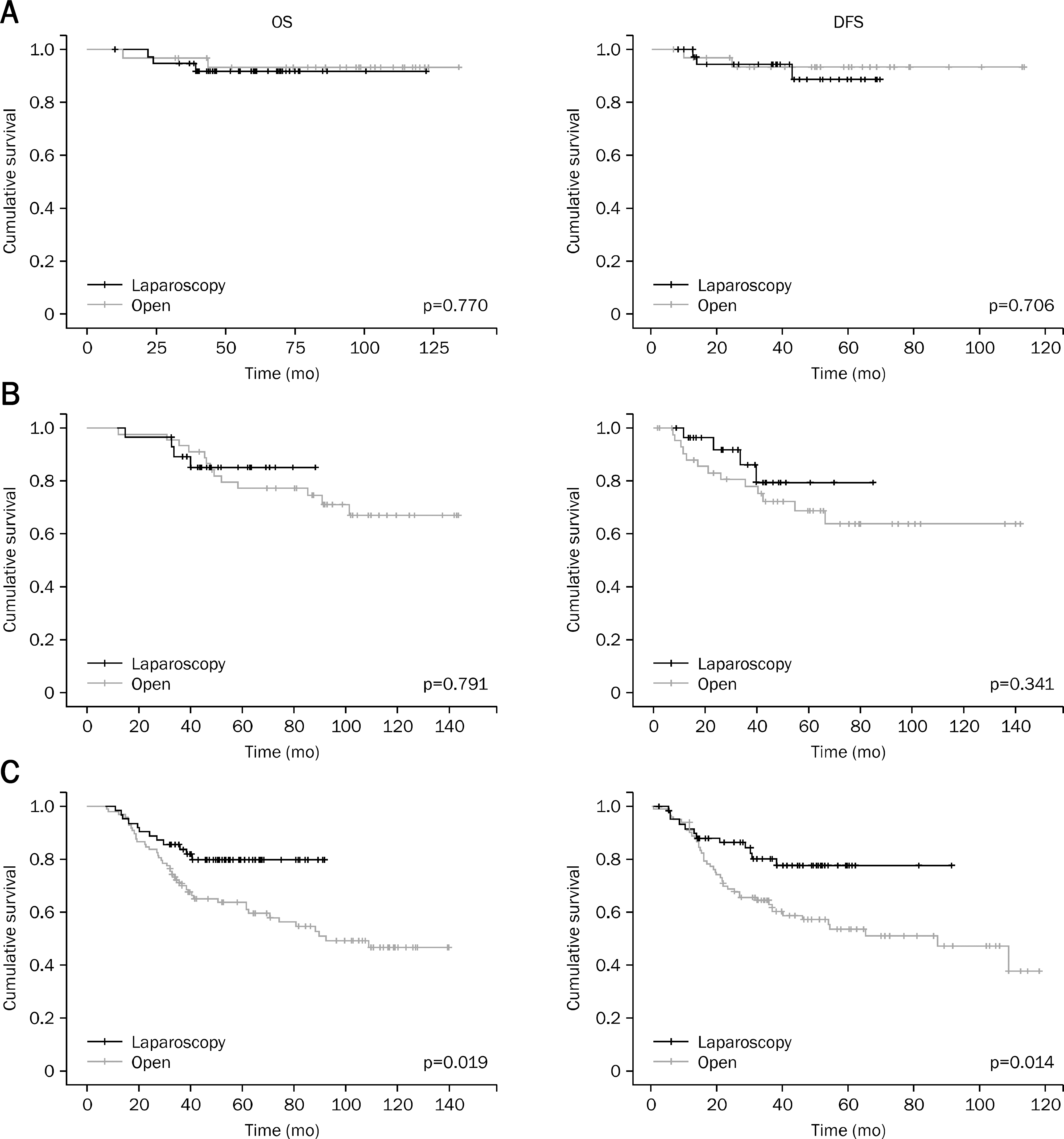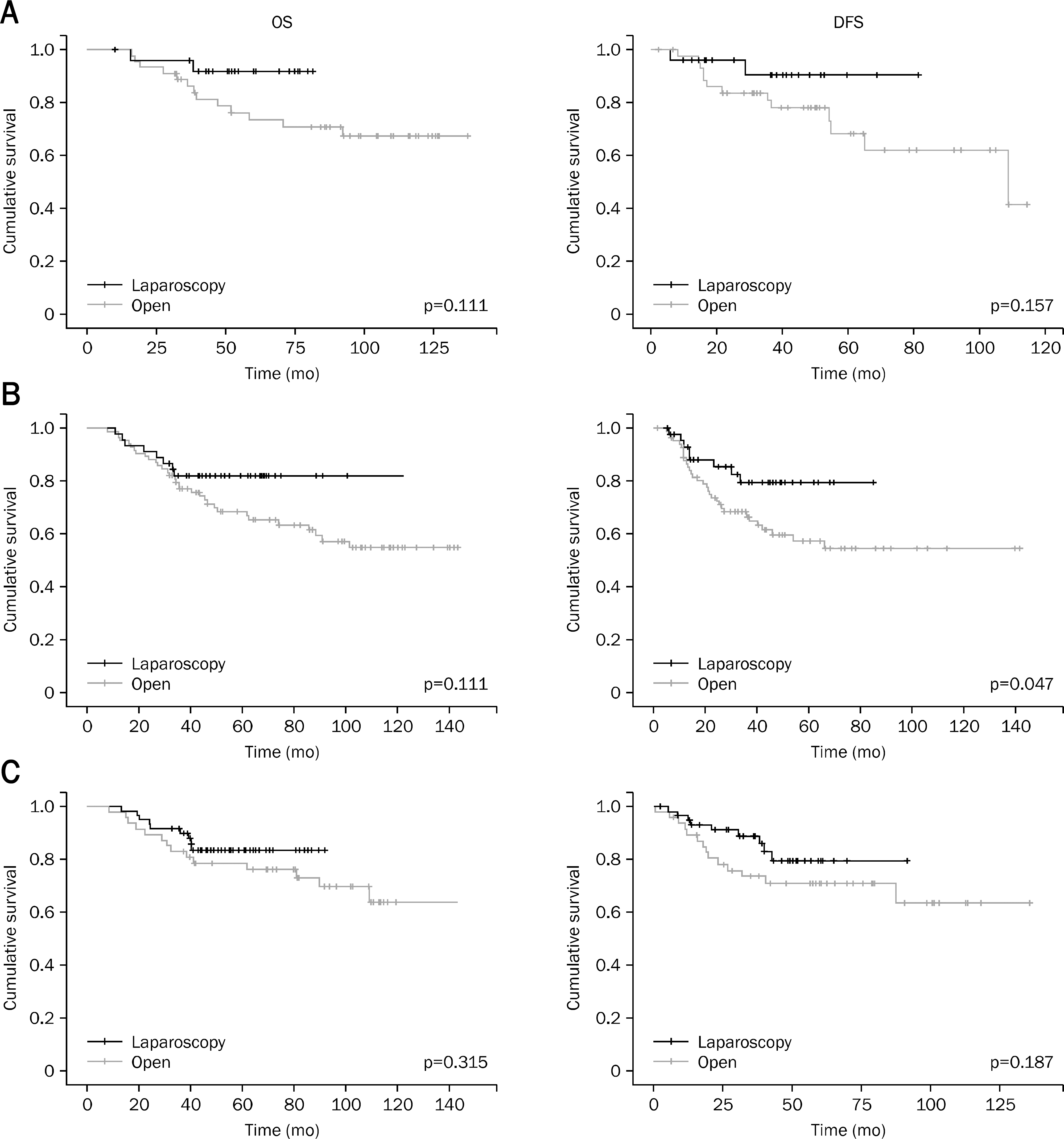Abstract
Background/Aims
Laparoscopic surgery has been proven to be an effective alternative to open surgery in patients with colon cancer. However, data on laparoscopic surgery in patients with rectal cancer are insufficient. The aim of this study was to compare the long-term outcomes of laparoscopic and open surgery in patients with rectal cancer.
Methods
A total of 307 patients with rectal cancer who were treated by open and laparoscopic curative resection at Kosin University Gospel Hospital (Busan, Korea) between January 2002 and December 2011 were reviewed retrospectively.
Results
Regarding treatment, 176 patients underwent an open procedure and 131 patients underwent a laparoscopic procedure. The local recurrence rate after laparoscopic resection was 2.3%, compared with 5.7% after open resection (p=0.088). Distant metastases occurred in 6.9% of the laparoscopic surgery group, compared with 24.4% in the open surgery group (p<0.001). In univariate analysis, age (≥75 years vs. ≤60 years), preoperative staging, surgical approach (open vs. laparoscopic), elevated initial CEA level, elevated follow-up CEA level, number of positive lymph nodes, and postoperative chemotherapy affected overall survival and disease free survival. However, in multivariate analysis, the surgical approach apparently did not affect long-term oncologic outcome.
References
1. Jemal A, Bray F, Center MM, Ferlay J, Ward E, Forman D. Global cancer statistics. CA Cancer J Clin. 2011; 61:69–90.

3. Ferlay J, Shin HR, Bray F, Forman D, Mathers C, Parkin DM. Estimates of worldwide burden of cancer in 2008: GLOBOCAN 2008. Int J Cancer. 2010; 127:2893–2917.

4. Kapiteijn E, Kranenbarg EK, Steup WH, et al. Total mesorectal excision (TME) with or without preoperative radiotherapy in the treatment of primary rectal cancer. Prospective randomised trial with standard operative and histopathological techniques. Dutch ColoRectal Cancer Group. Eur J Surg. 1999; 165:410–420.
5. Sauer R, Becker H, Hohenberger W, et al. German Rectal Cancer Study Group. Preoperative versus postoperative chemoradiotherapy for rectal cancer. N Engl J Med. 2004; 351:1731–1740.

6. Clinical Outcomes of Surgical Therapy Study Group. A comparison of laparoscopically assisted and open colectomy for colon cancer. N Engl J Med. 2004; 350:2050–2059.
7. Buunen M, Veldkamp R, Hop WC, et al. Colon Cancer Laparoscopic or Open Resection Study Group. Survival after laparoscopic surgery versus open surgery for colon cancer: long-term outcome of a randomised clinical trial. Lancet Oncol. 2009; 10:44–52.
8. Jayne DG, Guillou PJ, Thorpe H, et al. UK MRC CLASICC Trial Group. Randomized trial of laparoscopic-assisted resection of colorectal carcinoma: 3-year results of the UK MRC CLASICC Trial Group. J Clin Oncol. 2007; 25:3061–3068.

9. Lacy AM, García-Valdecasas JC, Delgado S, et al. laparoscopy-assisted colectomy versus open colectomy for treatment of non- metastatic colon cancer: a randomised trial. Lancet. 2002; 359:2224–2229.
10. Delaney CP, Chang E, Senagore AJ, Broder M. Clinical outcomes and resource utilization associated with laparoscopic and open colectomy using a large national database. Ann Surg. 2008; 247:819–824.

11. Kemp JA, Finlayson SR. Outcomes of laparoscopic and open colectomy: a national population-based comparison. Surg Innov. 2008; 15:277–283.

12. da Luz Moreira A, Mor I, Geisler DP, Remzi FH, Kiran RP. Laparoscopic resection for rectal cancer: a case-matched study. Surg Endosc. 2011; 25:278–283.

13. Lujan J, Valero G, Biondo S, Espin E, Parrilla P, Ortiz H. Laparoscopic versus open surgery for rectal cancer: results of a prospective multicentre analysis of 4,970 patients. Surg Endosc. 2013; 27:295–302.

14. Ng SS, Lee JF, Yiu RY, et al. Laparoscopic-assisted versus open total mesorectal excision with anal sphincter preservation for mid and low rectal cancer: a prospective, randomized trial. Surg Endosc. 2014; 28:297–306.

15. Seshadri RA, Srinivasan A, Tapkire R, Swaminathan R. Laparoscopic versus open surgery for rectal cancer after neoadjuvant chemoradiation: a matched case-control study of short-term outcomes. Surg Endosc. 2012; 26:154–161.

16. Jeong SY, Park JW, Nam BH, et al. Open versus laparoscopic surgery for mid-rectal or low-rectal cancer after neoadjuvant chemoradiotherapy (COREAN trial): survival outcomes of an open- label, non-inferiority, randomised controlled trial. Lancet Oncol. 2014; 15:767–774.
17. van der Pas MH, Haglind E, Cuesta MA, et al. COlorectal cancer Laparoscopic or Open Resection II (COLOR II) Study Group. Laparoscopic versus open surgery for rectal cancer (COLOR II): short-term outcomes of a randomised, phase 3 trial. Lancet Oncol. 2013; 14:210–218.

18. Ng SS, Leung KL, Lee JF, et al. Laparoscopic-assisted versus open abdominoperineal resection for low rectal cancer: a prospective randomized trial. Ann Surg Oncol. 2008; 15:2418–2425.

19. Chiang JM, Hsieh PS, Chen JS, Tang R, You JF, Yeh CY. Rectal cancer level significantly affects rates and patterns of distant metastases among rectal cancer patients post curative-intent surgery without neoadjuvant therapy. World J Surg Oncol. 2014; 12:197.

20. Tarantino I, Warschkow R, Worni M, et al. Elevated preoperative CEA is associated with worse survival in stage I-III rectal cancer patients. Br J Cancer. 2012; 107:266–274.

21. Das P, Skibber JM, Rodriguez-Bigas MA, et al. Predictors of tumor response and downstaging in patients who receive preoperative chemoradiation for rectal cancer. Cancer. 2007; 109:1750–1755.

22. Baik SH, Gincherman M, Mutch MG, Birnbaum EH, Fleshman JW. Laparoscopic vs open resection for patients with rectal can,!cer: comparison of perioperative outcomes and long-term survival. Dis Colon Rectum. 2011; 54:6–14.

23. Braga M, Frasson M, Vignali A, Zuliani W, Capretti G, Di Carlo V. Laparoscopic resection in rectal cancer patients: outcome and cost-benefit analysis. Dis Colon Rectum. 2007; 50:464–471.

24. Laurent C, Leblanc F, Wütrich P, Scheffler M, Rullier E. Laparoscopic versus open surgery for rectal cancer: long-term oncologic results. Ann Surg. 2009; 250:54–61.
25. Lujan J, Valero G, Hernandez Q, Sanchez A, Frutos MD, Parrilla P. Randomized clinical trial comparing laparoscopic and open surgery in patients with rectal cancer. Br J Surg. 2009; 96:982–989.

27. Mulcahy HE, Patchett SE, Daly L, O'Donoghue DP. Prognosis of elderly patients with large bowel cancer. Br J Surg. 1994; 81:736–738.

28. Colorectal Cancer Collaborative Group. Surgery for colorectal cancer in elderly patients: a systematic review. Lancet. 2000; 356:968–974.
Fig. 1.
Comparison of overall survival (OS) and disease-free survival (DFS) according to preoperative staging between open surgery group and laparoscopic surgery group. (A) Stage 1. (B) Stage 2. (C) Stage 3.

Fig. 2.
Comparison of overall survival (OS) and disease-free survival (DFS) according to tumor location between open surgery group and laparoscopic surgery group. (A) Upper (11–15 cm from anal verge). (B) Middle (6–10 cm from anal verge). (C) Lower (≤5 cm from anal verge).

Table 1.
Patient Characteristics
Table 2.
Pathological Data
Table 3.
Postoperative Recurrence according to Surgical Procedure
Table 4.
Univariate Analysis of Overall Survival and Disease-free Survival
Table 5.
Multivariate Analysis of Overall Survival and Disease-free Survival




 PDF
PDF ePub
ePub Citation
Citation Print
Print


 XML Download
XML Download